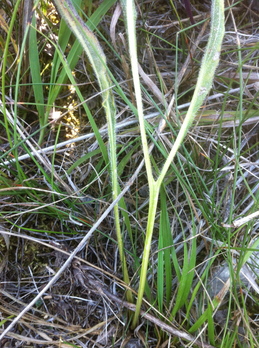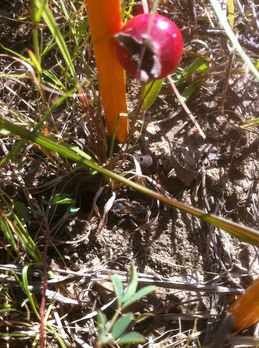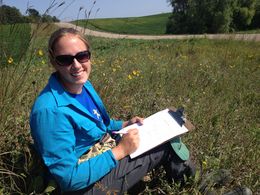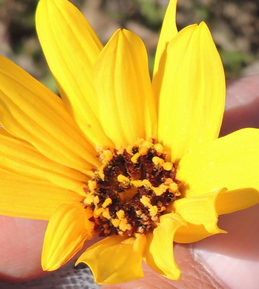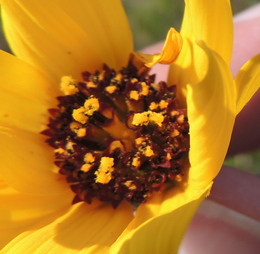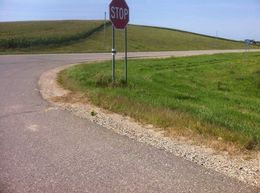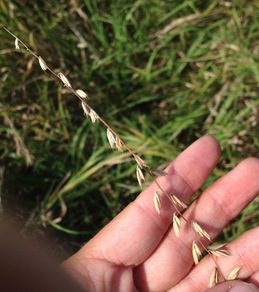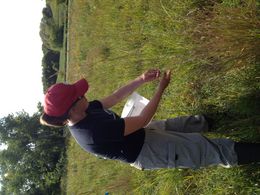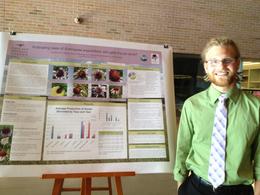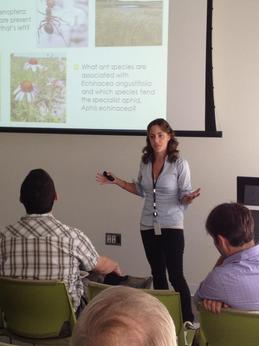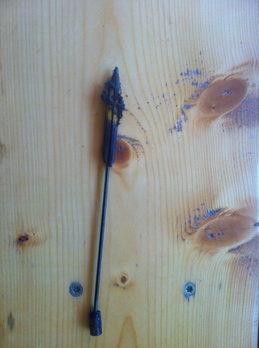|
|
Stuart is back!
While Stuart worked on computer stuff – prepping for rechecks at Landfill and nearest neighbors at Staffanson – Katherine and I finished off demo rechecks at Aanenson.
Apart from computer stuff, Stuart also finished seedling refinds at Randt (2 there), then set out for demo rechecks at Steven’s Approach. Katherine and I joined him after Aanenson. The three of us finished demo rechecks at a rate of ~1 plant per minute.
After lunch, we set out for demo rechecks at Landfill. On the way out we had an interesting and informative chat with Steve, a beekeeper about bees and pesticides etc.
At Landfill, we worked as a trio again. While Stuart staked with GPS, Katherine & I did demo, leapfrogging plants. We finished off 120 recheck points in about 2 hours, so again, rate of 1 plant per minute. We also flagged and demo-ed sling refind plants while at Landfill.
Lastly, we “(took) a moment to revel in the prairie that hasn’t been turned into landfill”. And rewarded ourselves with rootbeer floats. Katherine and I had too much ice cream that we didn’t have much appetite for dinner.

It’s quiet in the town hall. After Kelly and Jill left on Saturday, Maria and I had the place all to ourselves. We decided to use our Sunday to make a dent in the Echinacea Project to-do list.
First, we completed seedling refinds at three small sites (NWLF, NNWLF, and SGC) and made it a third of the way through a fourth (NESS). We also completed demography rechecks at Woody’s. This entails reconciling errors from this year’s census and collecting data on plants that flowered last year.
Woody’s happens to be one of Maria’s favorite sites. Notice the joy:

This morning, Team Echinacea headed out to Loeffler’s Corner to work on seedling re-finds. This site was a breeze compared with the challenges posed by Riley and KJ’s. While the plants at Riley are frequently disturbed by mowing and the plants at KJ’s are so dense that they’re practically growing on top of each other, the plants at Loeffler’s Corner are nicely spread out with easily findable seedlings.
In the afternoon, everyone made good progress on individual projects. Jill and I are both trying to wrap up our research in time for our last day on Friday. Jill and Katherine are sorting through the contents of Jill’s pitfall traps and preserving the ants that they won’t have time to identify for future study. Stuart and I are working to prepare my data to be analyzed in the winter when I hope to have an independent study to work on analysis. Maria is looking for Dicanthelium plants from which she can gather pollen in order to do a pollen viability test.
Here’s a picture of a neat plant that I found at Loeffler’s Corner. I think the leaves are somehow sharing the same petiole. Pretty cool!

Ruth came this morning with Stuart and Nicholas in tow, just in time for an all-day seedling refind extravaganza. This morning we knocked out East Riley, the frequently mowed prairie remnant with densely clustered Echinacea plants. Kelly and I took on some particularly challenging plants, but were rewarded with this:

A bee digging her nest next to one of our seedlings! By the time Kelly and I finished searching our plant, the bee had made a hole as big as she was!
After a hearty lunch, we did more seedling refinds, this time at Riley. Here’s Kelly with our first plant of the afternoon. 
The afternoon progressed quickly, ending with Maria, Stuart, Kelly, and I flagging plants for seedling refinds at Loeffler’s Corner– tomorrow’s project!
On Saturday, Katherine continued working with aphids–moving them about in the common garden. I (Karen) continued working on my style persistence project. I am testing style persistence as a measure of pollen limitation in perennial Helianthus species through different pollination treatments. There are some promising preliminary results: for many, when treated with compatible pollen, the styles will shrivel in 1-2 days and will persist longer when treated with incompatible pollen or restricted from pollen. The following pictures show Helianthus pauciflorus after four days with incompatible and compatible pollen, respectively.  ,toolbar=no,directories=no,location=no,menubar=no,status=no,left=0,top=0′); return false”> ,toolbar=no,directories=no,location=no,menubar=no,status=no,left=0,top=0′); return false”>
On Sunday, some of us took a trip to Glacial Lakes State Park for picnic lunch and 5mile hike. What a great outing!!!!
We kicked off the day refinding Amy’s Echinacea seedlings at KJ’s. If you couldn’t tell from the previous posts, we’re all quite exasperated with KJ’s. You can imagine how ecstatic we all were to wrap up the last 5 plants today and finally get a change of scenery– seedling refinds at East Elk Lake Road!
However, as soon as we arrived KJ’s this morning, I precariously balanced my water bottle on the truck bumper, and then realized we forgot the clipboards. Kelly took the truck to retrieve them and when she returned, clipboards in hand, I couldn’t find my water bottle anywhere. Musing that it got thrown into the neighboring soybean field, I was already conjuring up a birthday present request for a nalgene. That is, until we came to the intersection with 27:

My Nalgene got carried a full 3.3 MILES on the bumper of Stuart’s truck! Kelly is simply a smooth driver.
This afternoon we harvested Echinacea heads from the common garden and Hegg Lake, and then harvested Bouteloua curtipendula at both sites.


After lunch on Wednesday, Andrew and I left for Chicago to present our posters and give 5 minutes talks at the Chicago Botanic Garden. Thursday we navigated the city, got caught in a downpour, and missed our train. Friday we had better luck– we made it to the garden on time, stayed dry, and both gave strong presentations. In our downtime we visited the gift shop and toured the gardens.
Here are pictures from Friday:
Andrew’s Poster

My talk

Andrew and I after our presentations and pizza dinner

After a fairly cool start, we enjoyed a sunny and mild day that was perfect for field work.
Katherine was finishing up with the ants and aphids at Staffanson today. Karen continued pollination treatments on Helianthus species at Hegg Lake and Riley. The team worked on demography at various sites, pulling flags and taking GPS points.
We can’t wait to hear how about the REU symposium at the Chicago Botanic Garden that Jill and Andrew are attending today!
Today, we say farewell to yet another Team Echinacea 2012 member as Shona heads off to Vermont. The end of field season seems to be near…….
Thursday was a cool, beautiful day in Kensington. Our main task this week has been to finish up the first round of demography at all of the remnant prairies. Today Stuart, Gretel, Shona, and I went out to work on some of the smaller remnants (usually <10 flowering plants). Demography is a great way to allow us to keep track of plants over time and monitor the flowering patterns of both individuals and populations.
Katherine and Maria started on Katherine’s last round of ant and aphid surveys in the remnants today. It seems like the peak of aphid season has come and gone, but this last survey should help her determine the rate of decline of aphid populations (and maybe provide hints as to where they all go in the winter!).
After a few mishaps with regard to seedling re-finds (the process of re-finding the seedlings, or “slings”, that have been discovered during Amy’s seedling search experiment), I decided to write a haiku to best express our emotions:
Seedling re-finding
Basals, slings, all on visor?
No one really knows.
Thankfully, Amy and Stuart came through to save the day and we now have a much more firm grasp of our mission. In short:
Slings are important
Basals only if they’re near
Gotta find the slings.
Here’s a picture of a seedling that we found earlier this summer. Take a look at the two green cotyledons at the base of the plant. Cotyledons only appear in a plants first year of growing and are the only way to be sure that a plant is a seedling instead of just a small basal.

Today dawned slightly warmer than the past few days, and we spent a beautiful morning doing demography out at Staffanson. The west side of Staffanson was burned late this spring setting things back a little later than the east side and the remnants, and the big blue stem and indian grass are now in full bloom and about five feet tall. Dichanthelium is flowering, and I even saw a phlox, which I haven’t seen for weeks at any other site. The echinacea there have all finished flowering, but many still boast pink ray florets. The recent burn also removed all of the duff that we often have to dig through to find tags and check for nearby echinacea, and left everything greener and softer. One other result of the burn was this pencil that I found next to the last plant I demo’d. It looks like someone forgot to remove it from seedling searches…you can see the part that was sticking in the ground survived the flames.

It was Andrew’s last day today, he and Jill left after lunch to present their posters at the Chicago Botanical Gardens, and only Jill will return. To send him off we had rootbeer floats after a lunch which was also enhanced with bowls of delicious cucumbers, cantaloupe and grapes from the Wagenius gardens.
This afternoon we all had some time to work on our independent projects. Although we presented posters last Thursday I think all of us have plenty more that we could do. In some ways I feel like I have more work to do than when I started this summer, although much of it is still just ideas of new projects or parts of my project that I could build on if had more time. I did take the opportunity to get in a little more fieldwork, and Gretel drove out to Hegg Lake with me to help gather more data. We GPSed all of the plants for my crossing experiment again (the first time around the files got a little mixed up) as well as all flowering plants in my population of E. angustifolia. We also began developing a protocol to measure leaf pubescence for my characteristics study. From each plant we cut off the end of a leaf to be pressed and viewed under a scope, and then I painted a small patch of “new skin” (liquid band-aid) on the top of the leaf, waited for it to dry, peeled it off and mounted it on a slide also to look at under a microscope. While we were out there I completely lost track of time, and when Kelly called to see if we were done yet I was shocked to realize that it was already 5:30!
|
|



